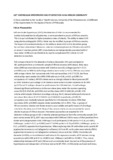Please use this identifier to cite or link to this item:
https://cris.library.msu.ac.zw//handle/11408/1684| Title: | Left ventricular hypertrophy and its detection in an African community | Authors: | Maunganidze, Fabian | Keywords: | Left ventricular hypertrophy, African community | Issue Date: | 2013 | Publisher: | University of the Witwatersrand | Abstract: | Left ventricular hypertrophy (LVH), the detection of which is recommended for routine risk prediction by all guidelines, is more prevalent in groups of African ancestry. This is in-part attributed to higher prevalence rates of obesity. The ability to detect LVH using electrocardiographic (ECG) criteria may be modified in groups of African ancestry. The impact of co-existent obesity on the ability to detect ECG-LVH in this ethnic group has not been determined. Moreover, whether estimated glomerular filtration rate (eGFR) or serum C-reactive protein (CRP concentrations are independently associated with LV mass index (LVMI) and can therefore be used to complement ECG criteria for LVH detection is uncertain. ECG voltage criteria for the detection of echocardiographic LVH were evaluated in 661 participants from a community sample of African ancestry (43% obese). Body mass index (BMI) was inversely associated with Sokolow-Lyon (SL) voltages (partial r=-0.27, p<0.0001) and no BMI-Cornell voltage relations were noted (p=0.21). BMI was associated with voltage criteria that incorporate only limb lead recordings (r=0.17-0.23), but these relationships were weaker than BMI-LVMI relations (r=0.36, p<0.01-p<0.0001 for comparisons of r values). All ECG criteria were as strongly related to blood pressure (BP) as LVMI. Sokolow-Lyon voltage-LVMI relations were noted only after adjustments for BMI (p<0.02) and SL voltages showed no performance for LVH detection. Cornell voltages showed significant performance in the non-obese (area under the receiver operating curve [AUC]=0.67±0.04, p<0.0005), but not the obese (AUC=0.56±0.04, p=0.08). ECG criteria which employ limb-lead recordings only (e.g. RaVL) showed better performance in non-obese than obese (AUC=0.75±0.04 and 0.59±0.04 respectively, p<0.005 for comparison) and markedly reduced specificity for LVH detection in obese (76%) than non-obese (92%, p<0.0001) despite similar sensitivities (32 vs 29%). Thus, in groups of African ancestry, obesity contributes toward a poor validity and performance of all voltage criteria for the detection of LVH. None of the current criteria are recommended for use in obesity in groups of African descent. Alternative approaches are required for LVH detection in these groups.In 621 randomly selected participants from the community sample [332 were normotensive (NT)], eGFR was associated with LVMI and LVM in excess of that predicted from stroke work (inappropriate LVM, LVMinappr) in all participants (LVMI: partial r=-0.18, p<0.0001; LVMinappr: partial r=-0.17, p<0.0001) and NT (LVMI: partial r=-0.23,p<0.0001; LVMinappr: partial r=-0.22, p<0.0001) separate from hypertensives. When replacing clinic BP with either aortic systolic BP (applanation tonometry and SphygmoCor software), 24-hour BP, aortic pulse wave velocity (PWV) (applanation tonometry and SphygmoCor software), stroke work (for LVMI), LV end diastolic diameter (LVEDD), or circumferential wall stress in the regression models, eGFR retained strong associations with LVMI (p=0.01 to <0.0001) and LVMinappr (p<0.005 to <0.0001). Thus, strong relationships between eGFR and LVM occur at a community level irrespective of the presence of hypertension and independent of 24-hour and aortic BP, PWV, LVEDD,stroke work and wall stress. The independent relationships between eGFR and LVMI, support the notion that eGFR may be evaluated for LVH detection. In 361 randomly selected participants from a community with a high prevalence of CRP concentrations considered to be high-risk (54.0%), but without cardiovascular or renal disease, serum CRP concentrations were correlated with both LVMI and LVMinappr (p<0.0001). With adjustments for a number of potential confounders including age, systolic BP, waist circumference (or BMI), and glucose control (glycated haemoglobin), the relationships between serum CRP concentrations and both LVMI and LVMinappr (partial r=0.11, p<0.05 for both) persisted. The independent relationship between CRP and LVMI or LVMinappr translated into a higher multivariate-adjusted LVMI and LVMinappr values in the highest as compared to the lowest quartile of CRP (LVMI; highest quartile CRP=48.8±10.7, lowest quartile CRP=45.0±11, p<0.05; LVMinappr; highest quartile CRP=137±24, lowest quartile CRP=127±24, p<0.05). The independent relationships between CRP and LVMI, support the notion that CRP may also be evaluated for LVH detection. In 358 participants from a randomly selected community sample with a high prevalence of obesity (41%), a combination of CRP concentrations and eGFR above or below the median for the sample respectively showed significant performance (AUC=0.61±0.03, p<0.0005), but a low specificity for LVH detection (77%). When eGFR and CRP concentrations were employed to complement RaVL, although the overall performance did not improve (AUC=0.71±0.03, p<0.0005, RaVL alone: AUC=0.70±0.03), the specificity increased (93%) whilst sensitivity (25%) was in-line with previously reported sensitivities for LVH detection using ECG criteria in alternative population samples. Without changing overall performance, eGFR together with RaVL increased the specificity to 88% and CRP concentrations when considered together with RaVL increased the specificity to 87%. Thus, in a community sample where the specificity and performance of ECG criteria for LVH detection are poor, the use of eGFR and/or CRP concentrations to complement ECG criteria increase the specificity without altering the overall performance. In conclusion, the present thesis provides evidence to indicate that current ECG criteria for the detection of LVH are invalid in obese individuals of African ancestry, but that clinical markers of renal dysfunction and systemic inflammation, which are associated with LVMI independent of haemodynamic factors and co-morbidities may be employed to complement ECG criteria to improve the specificity for LVH detection. | URI: | http://wiredspace.wits.ac.za/handle/10539/14600 http://hdl.handle.net/11408/1684 |
| Appears in Collections: | Thesis |
Files in This Item:
| File | Description | Size | Format | |
|---|---|---|---|---|
| Dr Maunganidze Thesis.pdf | 222.62 kB | Adobe PDF |  View/Open |
Page view(s)
70
checked on Feb 26, 2025
Download(s)
20
checked on Feb 26, 2025
Google ScholarTM
Check
Items in MSUIR are protected by copyright, with all rights reserved, unless otherwise indicated.


